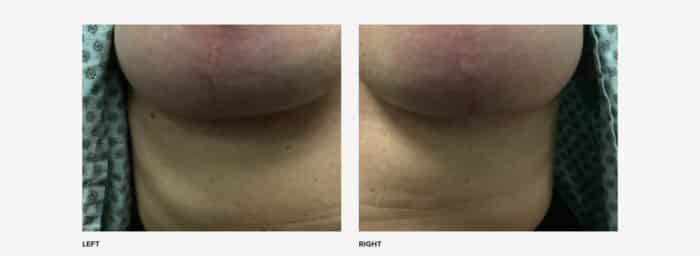Welcome to RealSelf’s new series, Seeing Scars. As part of our ongoing effort to boost transparency in plastic surgery, we’ll be showcasing incisions from various cosmetic procedures—across skin tones and at different stages of healing—to combat the fear and stigma surrounding surgical scars. Our latest installment explores breast lift scars.
Recently, when addressing a follower’s concerns about breast lift scarring on Instagram, New York City plastic surgeon Dr. Lara Devgan eloquently likened the popular surgery to a couture-gown fitting—and the resulting scars to seams. These lines, while certainly conspicuous, are an essential part of any well-tailored design, she explained, be it made of silk taffeta or human tissue.
Whether your mastopexy scars follow a vertical “lollipop” design or the arguably more powerful “anchor” pattern, they are undeniably front and center, traveling down from the areolas and dividing the lower half of the breasts. They do fade with time, of course. And for the 94% of patients who deem the breast lift “Worth It,” the scars seem to pale in comparison to the higher, perkier breast shape the surgery provides.
Ahead, we share an intimate look at how breast lift incisions heal on a variety of women. We’ve cropped the photos considerably so as not to show the entirety of the breasts, but the scars remain the focal point of our story.
Day 10, six weeks, and three months post-op

“Scars are a big part of plastic surgery. A patient is a good candidate for a procedure, like a breast lift or breast reduction, when they are not hyperfocused on scars. Every plastic surgeon plans for the best scars for their patients. Things like loose skin, previous surgery, tension, infection, and genetics all affect scars. Surgeons have some control over everything except for genetics. Patients should understand that a scar may take 12 to 24 months to declare itself. It used to be that patients were instructed to wait for a year before taking action on their scars. Now we like to be more proactive. Patients are instructed to massage their scars and consider topical silicone-based treatments starting two weeks after surgery. If scars appear not to be healing in the best manner, we begin other treatments at that two-week mark, if appropriate. These treatments include massage, lasers, microneedling, and possible steroid injections. Patients are encouraged to take an active, not passive, role in their scar healing and to work closely with their surgeon for the safest and best possible outcome.” —Dr. Sean Doherty, a board-certified plastic surgeon in Boston
One month, six months, and one year post-op

“This patient had a vertical, or lollipop, breast lift. The incisions looked good at one month and then turned a bit red in the interim. With patients who have lighter-colored skin, you will often see the redness of healing peaking through the skin tone early on. With good silicone cream care, this patient’s scars ended up continuing to lighten well over time. Scars tend to heal over the course of a whole year, so just leaving them alone for a bit and allowing them to naturally heal may be quicker than doing a scar revision too soon.” —Dr. Ramsen Azizi, a board-certified plastic surgeon in Chicago
Eight weeks post-op

“At eight weeks post-op from a mastopexy, this is a very typical scenario, where scars are slightly red and inflamed prior to settling as a fine white line. The patient is very happy with her scars in terms of thickness and symmetry. There is no widening beyond the borders of the incisions.” —Dr. Effie Pappas Politis, a board-certified plastic surgeon in Tampa, Florida
Nine weeks post-op

“These scars are nine weeks out from implant exchange, revision mastopexy, pocket repair, and placement of Galaflex [a supportive mesh scaffolding device]. Her skin tone is fairly neutral, so her scars are still pink. They are healing well. We would expect them to take longer to settle, since this was a revision mastopexy. We treat the scars for 12 weeks with either 3M brown paper tape [to help prevent thickening and widening] or silicone gel. I also place the Brijjit tension reduction devices on all vertical incisions for mastopexy, mastopexy/augmentation, and breast reductions. [These small, stick-on, plastic bracket-like devices form a bridge over a scar or wound, gently pinching together the surrounding skin, to eliminate pull.] This has dramatically improved the quality of the scars and also prevents breakdown of the wound at the T.
“If her scars were to remain pink at six months, we would treat with our Sciton BBL Hero. If they were thick, we would utilize SkinPen microneedling with PRP to soften the scars. You can also inject Botox, to soften thick scars, and/or use profractional lasers. We are lucky that we now have so many options with regard to scar treatment. I’ve also had several patients undergo medical tattooing at one year, to completely camouflage any residual scar.” —Dr. Ashley Gordon, a board-certified plastic surgeon in Austin, Texas
10 weeks post-op

“At 10 weeks out from a primary mastopexy/augmentation, this patient’s scars are still pink but healing well. This is expected, as she is very fair with lots of freckles. She will continue to tape [with 3M brown paper tape] for two more weeks, and then we will reevaluate at six months for Sciton BBL Hero. I don’t like to treat the scars with lasers or broad-based light too early because I don’t want to further aggravate or create more trauma during the initial healing phase. In 90% of cases, if we just give the scars time to mature, they fade away and don’t require any further intervention.” —Dr. Gordon
12 weeks post-op

“You can see, despite her dark skin tone, the scars have faded significantly at 12 weeks. They are not widened or raised. This patient was young, with a nice dermal layer. As plastic surgeons, we try not to cauterize or create thermal injury to the dermis of this skin, and we use sutures to approximate [or bring together] the dermal layer without constricting blood flow. ‘Kissing dermis’ is a term we use for balancing the right amount of suture so as to not place too many sutures and constrict blood supply.” —Dr. Politis
Six months post-op

“Dark skin forms darker scars. This patient’s vertical scars are thin but visible after six months. Her horizontal scars are well hidden in the breast crease. —Dr. Farah Naz Khan, a board-certified plastic surgeon in Dallas
Six months and two years post-op

“At six months, the vertical portion of her anchor scar is still pink—but by two years, it’s barely visible. Obviously, she heals well, but this shows that with time, scars lighten considerably.” —Dr. Khan











